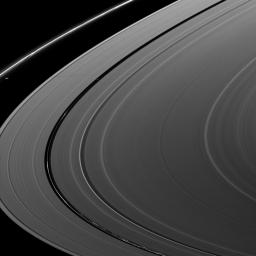
|
Prometheus and Pan Pair
- Click the image above for a larger view
- Full-Res JPEG (1016 x 1016) (77.3 kB)
- Full-Res TIFF (1016 x 1016) (1.0 MB)
Caption:
Saturn's moons Prometheus and Pan cast a pair of shadows on the A ring in this image taken shortly after the planet's August 2009 equinox.
Pan (28 kilometers, or 17 miles across) orbits in the Encke Gap of the A ring, and it can be seen casting a shadow to the right of and a little below Prometheus' shadow in this image.
The gravity of potato-shaped Prometheus (86 kilometers, or 53 miles across) periodically creates streamer-channels in the F ring, and the moon's handiwork can be seen above the moon in this image. To learn more and to watch a movie of this process, see PIA08397 .
Kinky, discontinuous ringlets in the Encke Gap are also visible at the bottom of the image. See PIA11676 to learn more.
The novel illumination geometry that accompanies equinox lowers the sun's angle to the ringplane, significantly darkens the rings, and causes out-of-plane structures to look anomalously bright and cast shadows across the rings. These scenes are possible only during the few months before and after Saturn's equinox, which occurs only once in about 15 Earth years. Before and after equinox, Cassini's cameras have spotted not only the predictable shadows of some of Saturn's moons (see PIA11657 ), but also the shadows of newly revealed vertical structures in the rings themselves (see PIA11665 ).
This view looks toward the northern, sunlit side of the rings from about 8 degrees above the ringplane. The main rings have been brightened relative to the F-ring to increase visibility.
The image was taken in visible light with the Cassini spacecraft narrow-angle camera on Aug. 21, 2009. The view was acquired at a distance of approximately 2.2 million kilometers (1.4 million miles) from Saturn. Image scale is 13 kilometers (8 miles) per pixel.
Background Info:
The Cassini-Huygens mission is a cooperative project of NASA, the European Space Agency and the Italian Space Agency. The Jet Propulsion Laboratory, a division of the California Institute of Technology in Pasadena, manages the mission for NASA's Science Mission Directorate, Washington, D.C. The Cassini orbiter and its two onboard cameras were designed, developed and assembled at JPL. The imaging operations center is based at the Space Science Institute in Boulder, Colo.
For more information about the Cassini-Huygens mission visit http://saturn.jpl.nasa.gov/ . The Cassini imaging team homepage is at http://ciclops.org .
Cataloging Keywords:
| Name | Value | Additional Values |
|---|---|---|
| Target | Saturn Rings | A Ring, Encke Gap, Pan, Prometheus, Saturn |
| System | Saturn | |
| Target Type | Ring | Gap, Planet, Satellite |
| Mission | Cassini-Huygens | |
| Instrument Host | Cassini Orbiter | |
| Host Type | Orbiter | |
| Instrument | Imaging Science Subsystem (ISS) | |
| Detector | Narrow Angle Camera | |
| Extra Keywords | Grayscale, Shadow, Visual | |
| Acquisition Date | ||
| Release Date | 2009-10-19 | |
| Date in Caption | 2009-08-21 | |
| Image Credit | NASA/JPL/Space Science Institute | |
| Source | photojournal.jpl.nasa.gov/catalog/PIA11604 | |
| Identifier | PIA11604 | |
